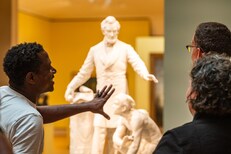 Marilyn Hoffman Executive Search Consultant and Principal Museum Search & Reference www.museum-search.com
Marilyn Hoffman Executive Search Consultant and Principal Museum Search & Reference www.museum-search.com The Era of the Visionary Museum Director Is Over … or It Should Be

I have found that the job of museum director is less about fantastical visions and more about defining practical objectives and choices for the entire institution and its constituents. The objectives are place-specific, and cannot be known in advance. As directors we must keep envisioning at the 1000-foot view, but unless we can ground that view in pragmatic examples that help our teams link aspiration to action, the 1000-foot view remains an elusive and frustrating dream. Being a director requires understanding process and articulating how to manage change, evaluate the institution, and develop staff and community partners thoughtfully. These steps, over time, will realize goals even more exceptional than one could have predicted.
While recognizing that every museum has its own unique challenges, audiences, and possibilities, I’d like to share three of the ways the Chazen is starting to interrogate and experiment with our approach to realizing the museum’s mission.
Imagine for a moment everyone in the organization prioritizing one or two goals each year concerning diversity, equity, inclusion, and accessibility. How far can an organization shift if everyone on the team becomes responsible for actionable items in their own area? Small steps, accumulated, make a huge difference. We have implemented this process at the Chazen for the first time this year. Already, it is changing the way some staff view their portfolio of work and how it’s critically linked to our strategic goals.
Providing multiple access points to the Chazen’s wide-ranging collection is central to our mission to serve campus and community audiences. Among our diverse holdings is a pedestal-sized, marble version of “The Emancipation Group” (1873), by Thomas Ball. A collaborative project created with artist Sanford Biggers and the MASK Consortium, entitled “RE:mancipation,” will study this sculpture and its complex history while cultivating a more nuanced understanding of our nation and ourselves. This important work cannot be solely institutionally driven, it must be conducted in partnership with artists, and the results of such projects should influence how we approach all collection display and interpretation.

 RSS Feed
RSS Feed